Rheological and Flocculation Analysis of Microfibrillated Cellulose Suspension Using Optical Coherence Tomography
Abstract
:Featured Application
Abstract
1. Introduction
2. Materials and Methods
3. Results and Discussion
4. Conclusions
Author Contributions
Acknowledgments
Conflicts of Interest
References
- Isogai, A. Wood nanocelluloses: Fundamentals and applications as new bio-based nanomaterials. J. Wood Sci. 2013, 59, 449–459. [Google Scholar] [CrossRef]
- Klemm, D.; Kramer, F.; Moritz, S.; Lindström, T.; Ankerfors, M.; Gray, D.; Dorris, A. Nanocelluloses: A New Family of Nature-Based Materials. Angew. Chem. Int. Ed. 2011, 50, 5438–5466. [Google Scholar] [CrossRef] [PubMed]
- Moon, R.J.; Schueneman, G.T.; Simonsen, J. Overview of Cellulose Nanomaterials, Their Capabilities and Applications. JOM 2016, 68, 2383–2394. [Google Scholar] [CrossRef]
- Naderi, A.; Lindström, T. Rheological measurements on nanofibrillated cellulose systems: A science in progress. In Cellulose and Cellulose Derivatives: Synthesis, Modification and Applications; Mondal, M.I.H., Ed.; Nova Science Publishers: New York, NY, USA, 2015. [Google Scholar]
- Nazari, B.; Kumar, V.; Bousfield, D.W.; Toivakka, M. Rheology of cellulose nanofibers suspensions: Boundary driven flow. J. Rheol. 2016, 60, 1151–1159. [Google Scholar] [CrossRef]
- Kumar, V.; Nazari, B.; Bousfield, D.W.; Toivakka, M. Rheology of microfibrillated cellulose suspensions in pressure-driven flow. Appl. Rheol. 2016, 26, 43534. [Google Scholar] [CrossRef]
- Karppinen, A.; Saarinen, T.; Salmela, J.; Laukkanen, A.; Nuopponen, M.; Seppälä, J. Flocculation of microfibrillated cellulose in shear flow. Cellulose 2012, 19, 1807–1819. [Google Scholar] [CrossRef]
- Saarikoski, E.; Saarinen, T.; Salmela, J.; Seppälä, J. Flocculated flow of microfibrillated cellulose water suspensions: An imaging approach for characterisation of rheological behaviour. Cellulose 2012, 19, 647–659. [Google Scholar] [CrossRef]
- Saarinen, T.; Haavisto, S.; Sorvari, A.; Salmela, J.; Seppälä, J. The effect of wall depletion on the rheology of microfibrillated cellulose water suspensions by optical coherence tomography. Cellulose 2014, 21, 1261–1275. [Google Scholar] [CrossRef]
- Lauri, J.; Koponen, A.; Haavisto, S.; Czajkowski, J.; Fabritius, T. Analysis of rheology and wall depletion of microfibrillated cellulose suspension using optical coherence tomography. Cellulose 2017, 24, 4715–4728. [Google Scholar] [CrossRef]
- Swerin, A.; Ödberg, L.; Lindström, T. Deswelling of hardwood kraft pulp fibers by cationic polymers. Nord. Pulp. Pap. Res. J. 1990, 5, 188–196. [Google Scholar] [CrossRef]
- Huang, D.; Swanson, E.; Lin, C.; Schuman, J.; Stinson, W.; Chang, W.; Hee, M.; Flotte, T.; Gregory, K.; Puliafito, C.; et al. Optical coherence tomography. Science 1991, 254, 1178–1181. [Google Scholar] [CrossRef] [PubMed]
- Zhao, Y.; Chen, Z.; Saxer, C.; Xiang, S.; de Boer, J.F.; Nelson, J.S. Phase-resolved optical coherence tomography and optical Doppler tomography for imaging blood flow in human skin with fast scanning speed and high velocity sensitivity. Opt. Lett. 2000, 25, 114–116. [Google Scholar] [CrossRef] [PubMed]
- Wang, X.J.; Milner, T.E.; Nelson, J.S. Characterization of fluid flow velocity by optical Doppler tomography. Opt. Lett. 1995, 20, 1337–1339. [Google Scholar] [CrossRef] [PubMed]
- Wang, R.K. High-resolution visualization of fluid dynamics with Doppler optical coherence tomography. Meas. Sci. Technol. 2004, 15, 725–733. [Google Scholar] [CrossRef]
- Bonesi, M.; Churmakov, D.; Meglinski, I. Study of flow dynamics in complex vessels using Doppler optical coherence tomography. Meas. Sci. Technol. 2007, 18, 3279–3286. [Google Scholar] [CrossRef]
- Lauri, J.; Bykov, A.V.; Priezzhev, A.V.; Myllylä, R. Experimental study of the multiple scattering effect on the flow velocity profiles measured in Intralipid phantoms by DOCT. Laser Phys. 2011, 21, 813–817. [Google Scholar] [CrossRef]
- Haavisto, S.; Salmela, J.; Koponen, A. Accurate velocity measurements of boundary-layer flows using Doppler optical coherence tomography. Exp. Fluids 2015, 56, 96. [Google Scholar] [CrossRef]
- Malm, A.V.; Waigh, T.A. Elastic turbulence in entangled semi-dilute DNA solutions measured with optical coherence tomography velocimetry. Sci. Rep. 2017, 7, 1186. [Google Scholar] [CrossRef] [PubMed]
- Harvey, M.; Waigh, T.A. Optical coherence tomography velocimetry in controlled shear flow. Phys. Rev. E 2011, 83, 031502. [Google Scholar] [CrossRef] [PubMed]
- Jaradat, S.; Harvey, M.; Waigh, T.A. Shear-banding in polyacrylamide solutions revealed via optical coherence tomography velocimetry. Soft Matter 2012, 8, 11677–11686. [Google Scholar] [CrossRef]
- Lauri, J.; Bykov, A.V.; Myllyla, R. Determination of suspension viscosity from the flow velocity profile measured by Doppler Optical Coherence Tomography. Photonics Lett. Pol. 2011, 3, 82–84. [Google Scholar] [CrossRef]
- Haavisto, S.; Salmela, J.; Jäsberg, A.; Saarinen, T.; Karppinen, A.; Koponen, A. Rheological characterization of microfibrillated cellulose suspension using optical coherence tomography. TAPPI J. 2015, 14, 291–302. [Google Scholar]
- Czajkowski, J.; Vilmi, P.; Lauri, J.; Sliz, R.; Fabritius, T.; Myllyla, R. Characterization of ink-jet printed RGB color filters with spectral domain optical coherence tomography. In Proceedings of the SPIE 8493, Interferometry XVI: Techniques and Analysis, San Diego, CA, USA, 16 July 2012; pp. 849308–849308-7. [Google Scholar] [CrossRef]
- Lauri, J.; Czajkowski, J.; Myllylä, R.; Fabritius, T. Measuring flow dynamics in a microfluidic chip using optical coherence tomography with 1 µm axial resolution. Flow Meas. Instrum. 2015, 43, 1–5. [Google Scholar] [CrossRef]
- Barnes, H.A. A review of the slip (wall depletion) of polymer solutions, emulsions and particle suspensions in viscometers: Its cause, character, and cure. J. Non Newton. Fluid Mech. 1995, 56, 221–251. [Google Scholar] [CrossRef]
- Petrich, M.P.; Koch, D.L.; Cohen, C. An experimental determination of the stress-microstructure relationship in semi-concentrated fiber suspensions. J. Non Newton. Fluid Mech. 2000, 95, 101–133. [Google Scholar] [CrossRef]
- Bounoua, S.; Lemaire, E.; Férec, J.; Ausias, G.; Kuzhir, P. Shear-thinning in concentrated rigid fiber suspensions: Aggregation induced by adhesive interactions. J. Rheol. 2016, 60, 1279–1300. [Google Scholar] [CrossRef]
- Agoda-Tandjawa, G.; Durand, S.; Berot, S.; Blassel, C.; Gaillard, C.; Garnier, C.; Doublier, J.-L. Rheological characterization of microfibrillated cellulose suspensions after freezing. Carbohydr. Polym. 2010, 80, 677–686. [Google Scholar] [CrossRef]
- Iotti, M.; Gregersen, Ø.W.; Moe, S.; Lenes, M. Rheological Studies of Microfibrillar Cellulose Water Dispersions. J. Polym. Environ. 2011, 19, 137–145. [Google Scholar] [CrossRef]
- Mykhaylyk, O.O.; Warren, N.J.; Parnell, A.J.; Pfeifer, G.; Laeuger, J. Applications of shear-induced polarized light imaging (SIPLI) technique for mechano-optical rheology of polymers and soft matter materials. J. Polym. Sci. Pol. Phys. 2016, 54, 2151–2170. [Google Scholar] [CrossRef]
- Hourani, M.J. Fiber flocculation in pulp suspension flow: Part 2. Experimental results. TAPPI J. 1988, 71, 186–189. [Google Scholar]
- Hourani, M.J. Fiber flocculation in pulp suspension: Part 1. Theoretical model. TAPPI J. 1988, 71, 115–118. [Google Scholar]
- Coufort, C.; Dumas, C.; Bouyer, D.; Liné, A. Analysis of floc size distributions in a mixing tank. Chem. Eng. Process. Process Intensif. 2008, 47, 287–294. [Google Scholar] [CrossRef]
- Shin, J.H.; Son, M.; Lee, G. Stochastic Flocculation Model for Cohesive Sediment Suspended in Water. Water 2015, 7, 2527–2541. [Google Scholar] [CrossRef]
- Kerekes, R.J. Pulp floc behaviour in entry flow to constrictions [Paper industry]. TAPPI J. 1983, 66, 88–91. [Google Scholar]
- Thomas, D.N.; Judd, S.J.; Fawcett, N. Flocculation modelling: A review. Water Res. 1999, 33, 1579–1592. [Google Scholar] [CrossRef]
- Jarvis, P.; Jefferson, B.; Gregory, J.; Parsons, S.A. A review of floc strength and breakage. Water Res. 2005, 39, 3121–3137. [Google Scholar] [CrossRef] [PubMed] [Green Version]
- Cui, H.; Grace, J.R. Flow of pulp fibre suspension and slurries: A review. Int. J. Multiph. Flow 2007, 33, 921–934. [Google Scholar] [CrossRef]
- Keshtkar, M.; Heuzey, M.C.; Carreau, P.J. Rheological behavior of fiber-filled model suspensions: Effect of fiber flexibility. J. Rheol. 2009, 53, 631–650. [Google Scholar] [CrossRef]
- Son, M.; Hsu, T.-J. The effect of variable yield strength and variable fractal dimension on flocculation of cohesive sediment. Water Res. 2009, 43, 3582–3592. [Google Scholar] [CrossRef] [PubMed]
- François, R.J. Strength of aluminium hydroxide flocs. Water Res. 1987, 21, 1023–1030. [Google Scholar] [CrossRef]
- Sonntag, R.C.; Russel, W.B. Structure and breakup of flocs subjected to fluid stresses. J. Colloid Interface Sci. 1986, 113, 399–413. [Google Scholar] [CrossRef]
- Biggs, C.A.; Lant, P.A. Activated sludge flocculation: On-line determination of floc size and the effect of shear. Water Res. 2000, 34, 2542–2550. [Google Scholar] [CrossRef]
- Hubbe, M. Flocculation and redispersion of cellulosic fiber suspensions: A review of effects of hydrodynamic shear and polyelectrolytes. BioResources 2007, 2, 296–331. [Google Scholar]
- Blaser, S. Break-up of flocs in contraction and swirling flows. Colloid Surface A 2000, 166, 215–223. [Google Scholar] [CrossRef]
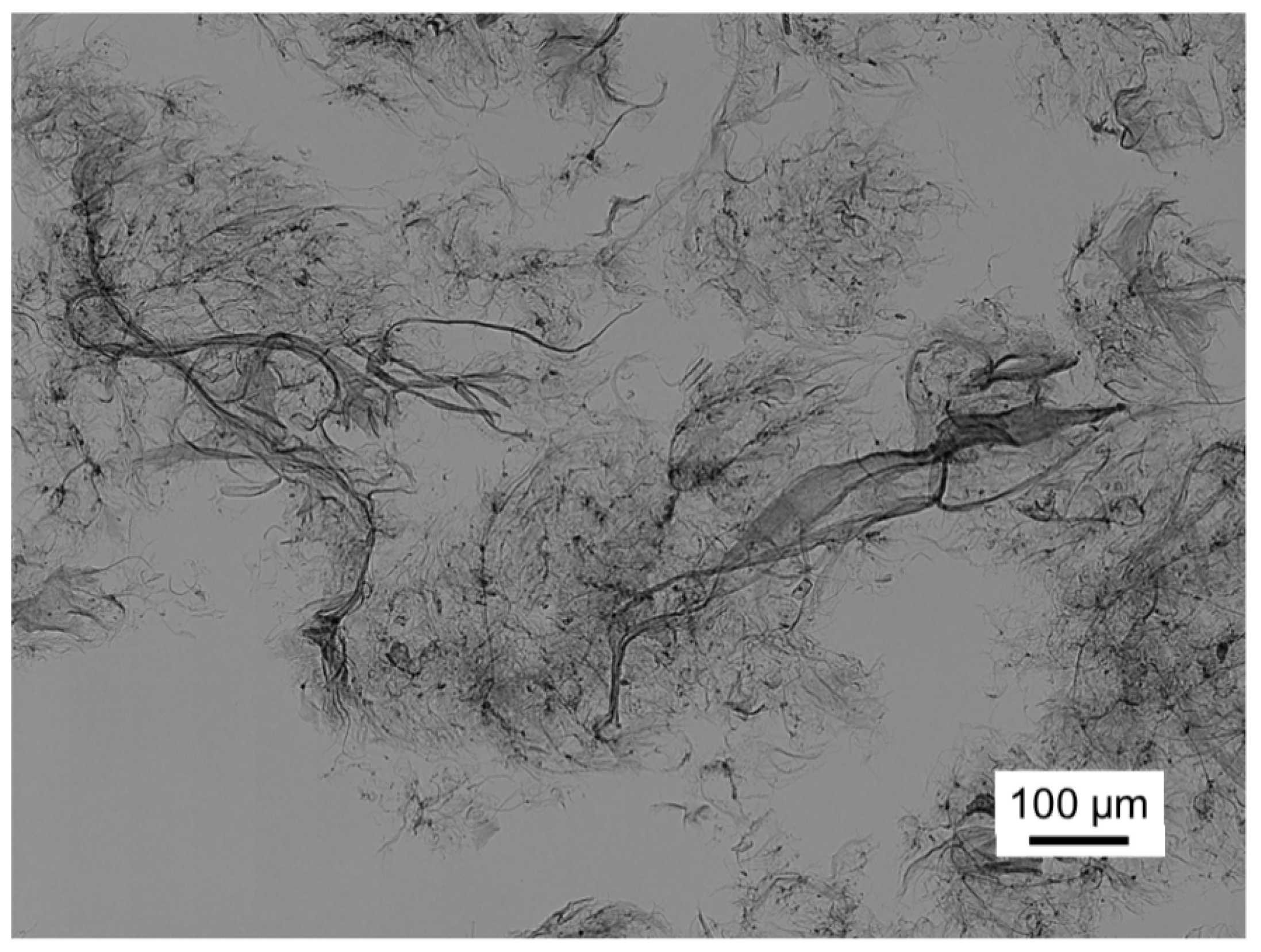
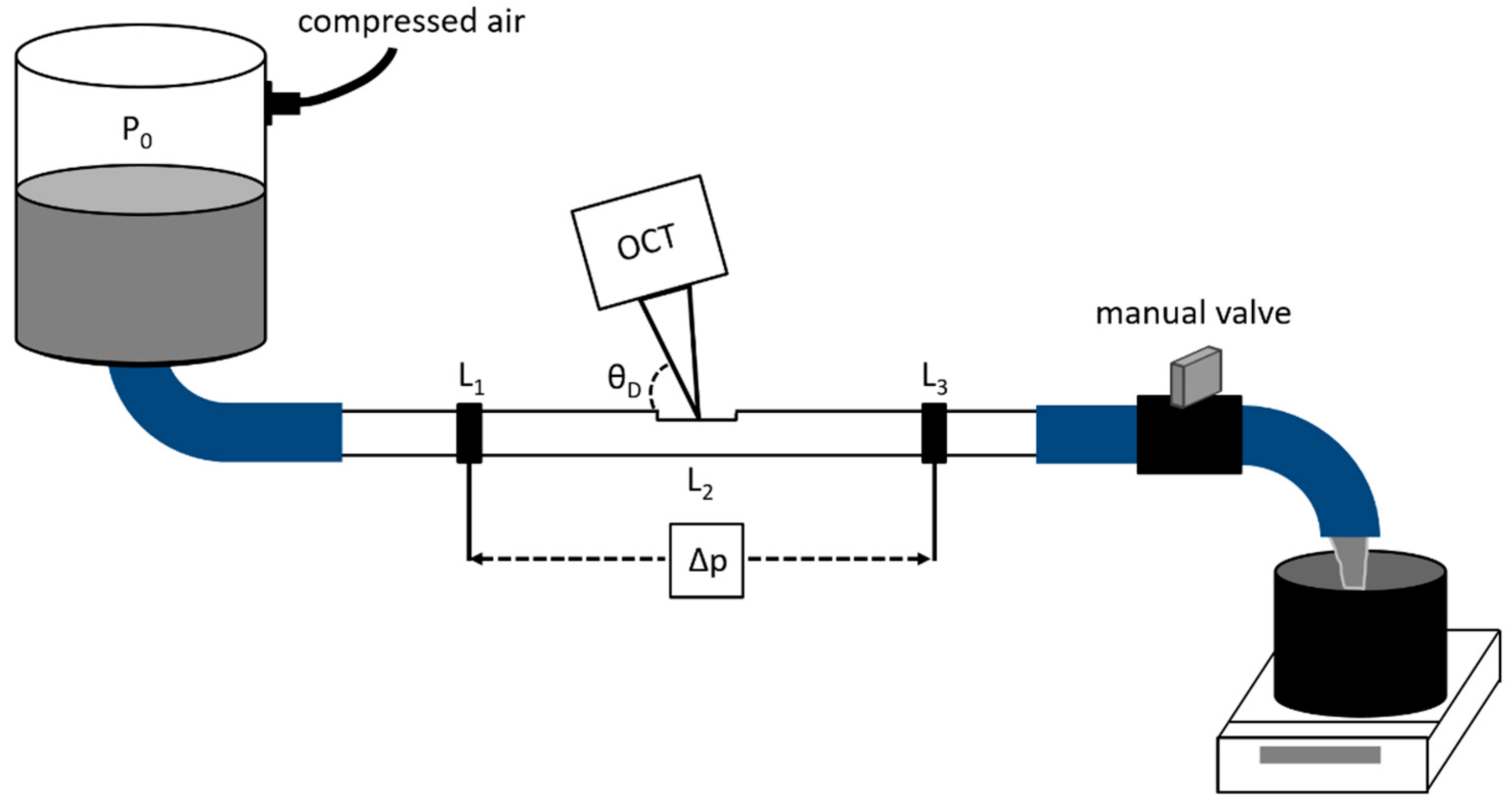
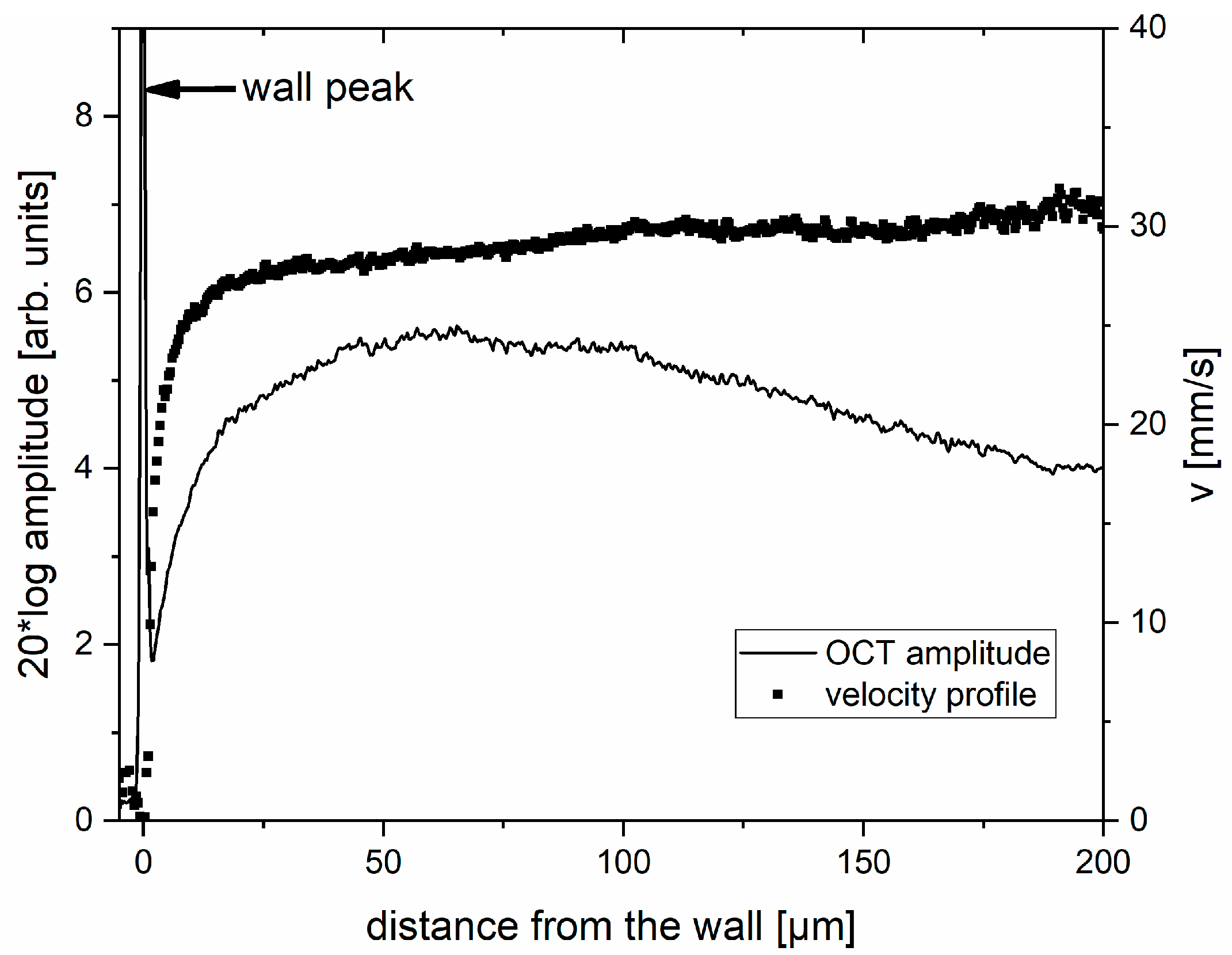
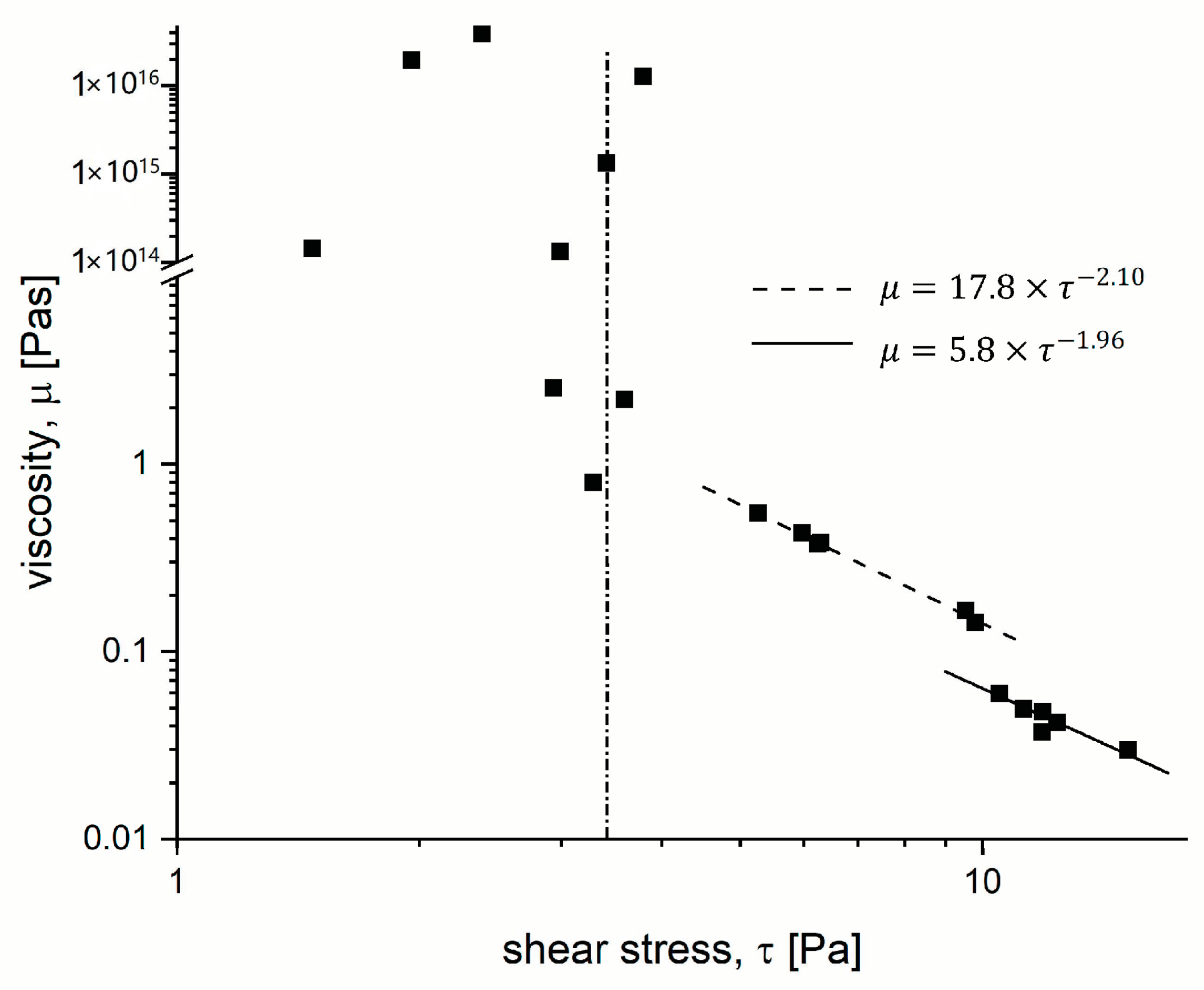
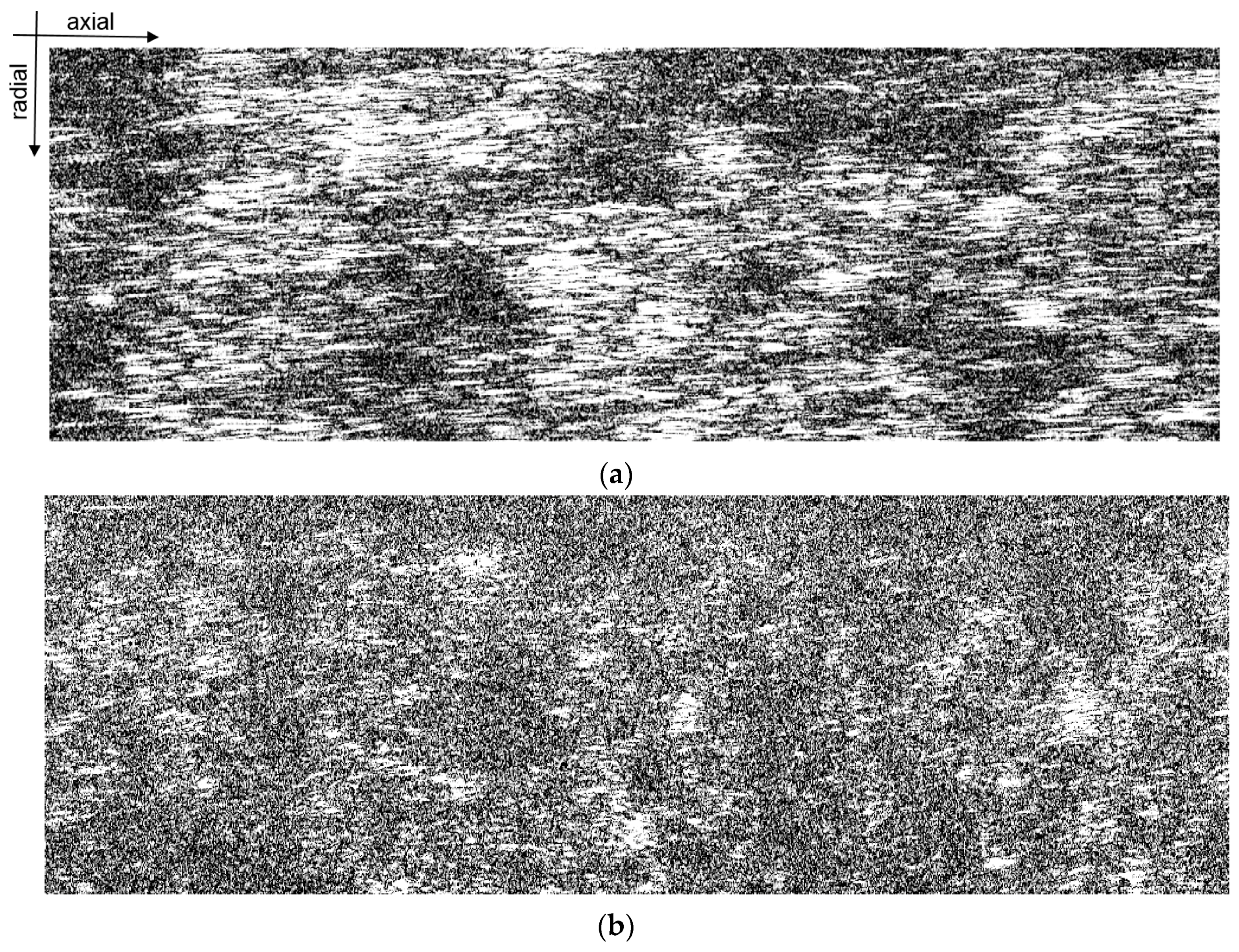
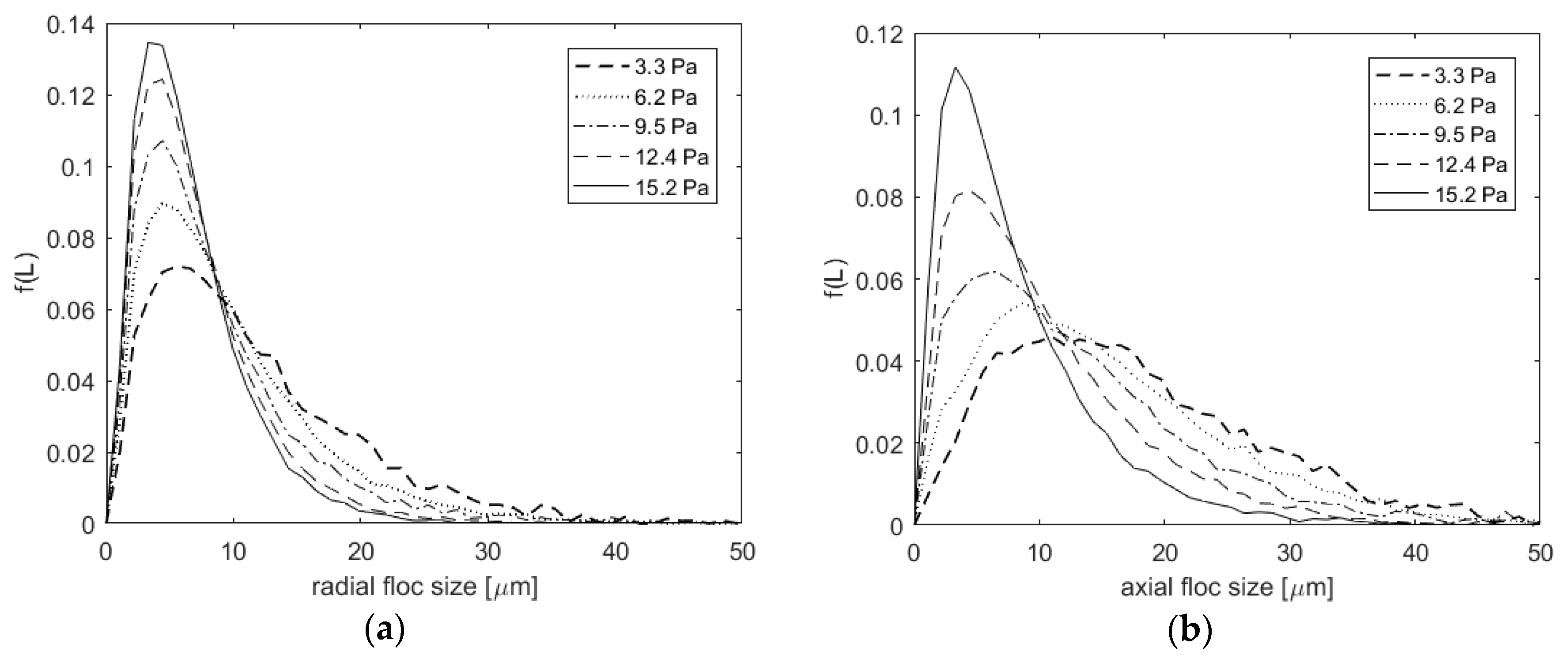
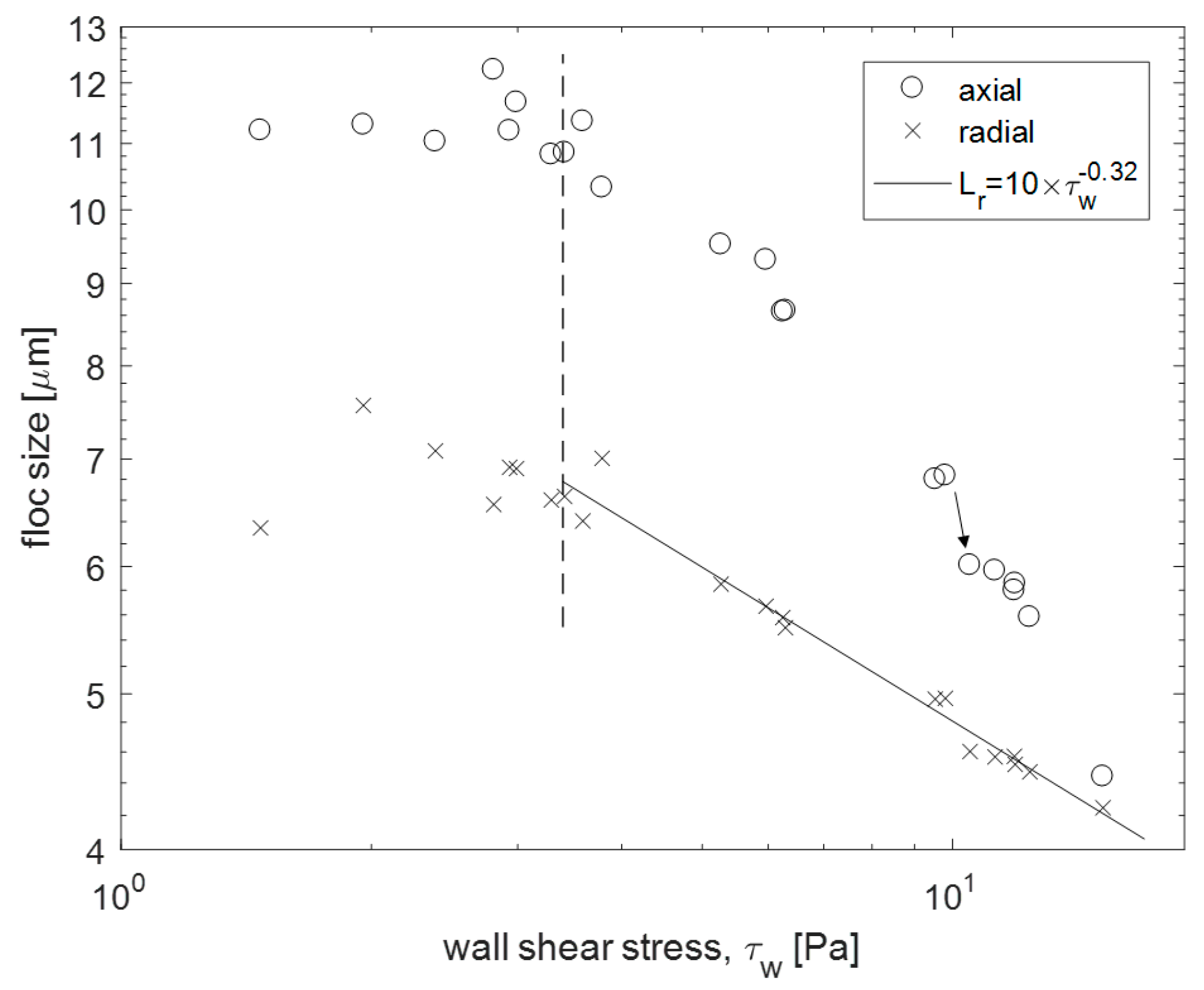
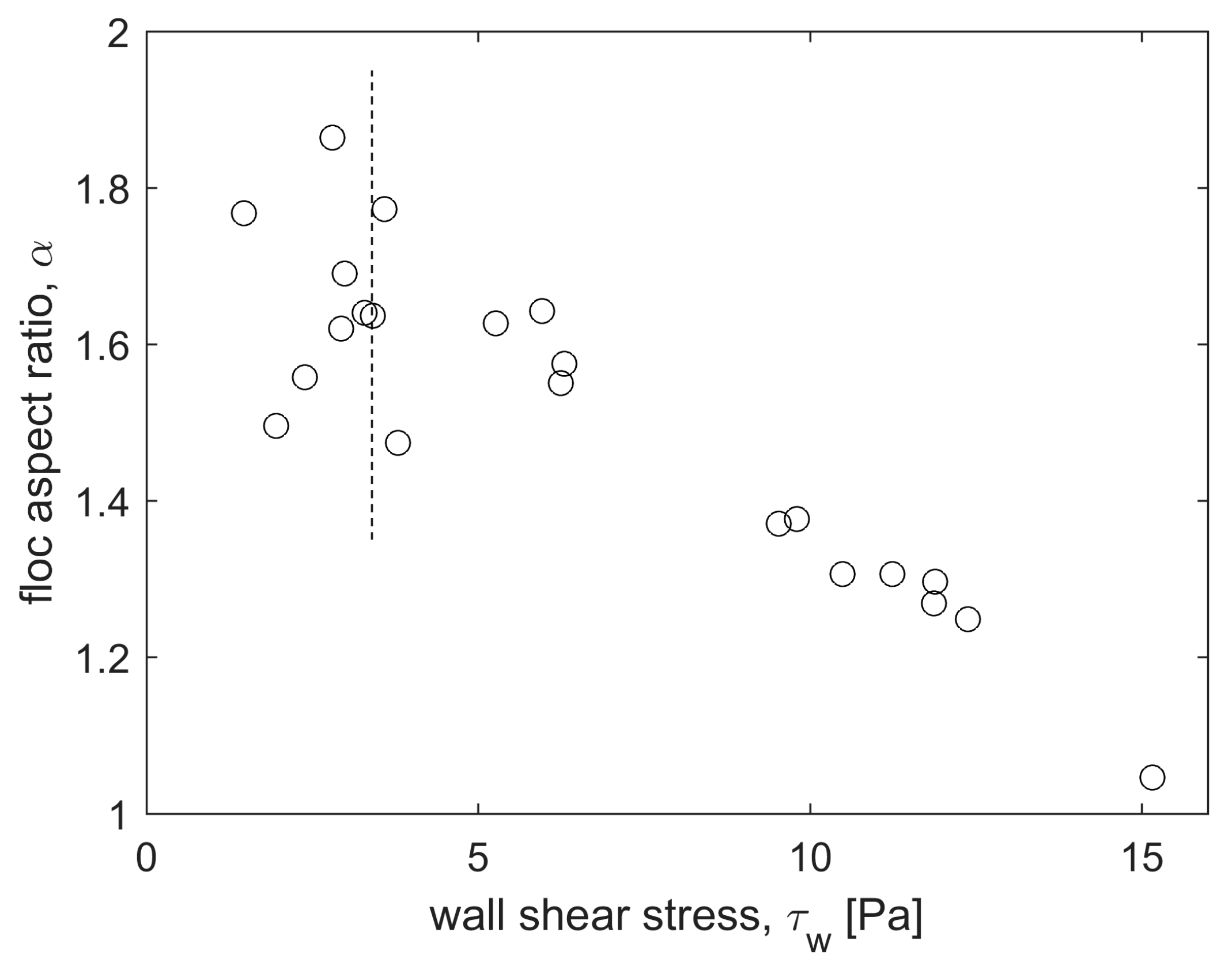
© 2018 by the authors. Licensee MDPI, Basel, Switzerland. This article is an open access article distributed under the terms and conditions of the Creative Commons Attribution (CC BY) license (http://creativecommons.org/licenses/by/4.0/).
Share and Cite
Koponen, A.I.; Lauri, J.; Haavisto, S.; Fabritius, T. Rheological and Flocculation Analysis of Microfibrillated Cellulose Suspension Using Optical Coherence Tomography. Appl. Sci. 2018, 8, 755. https://doi.org/10.3390/app8050755
Koponen AI, Lauri J, Haavisto S, Fabritius T. Rheological and Flocculation Analysis of Microfibrillated Cellulose Suspension Using Optical Coherence Tomography. Applied Sciences. 2018; 8(5):755. https://doi.org/10.3390/app8050755
Chicago/Turabian StyleKoponen, Antti I., Janne Lauri, Sanna Haavisto, and Tapio Fabritius. 2018. "Rheological and Flocculation Analysis of Microfibrillated Cellulose Suspension Using Optical Coherence Tomography" Applied Sciences 8, no. 5: 755. https://doi.org/10.3390/app8050755




